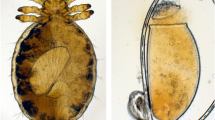Abstract
In the present study, the efficacy of water-free neem seed extract shampoo Wash Away Louse®, provided by Alpha-Biocare GmbH, Düsseldorf (Germany), was investigated against Sarcoptes scabiei infesting dogs in Egypt. Ten naturally infested dogs were collected from different areas in the Nile delta. The occurrence of lesions, hair loss, and skin inflammation were regarded as signs of infestation and proved by detection of adult parasites and their developmental stages in scrapings of infested lesions. Adequate amount of the provided shampoo was applied topically and spread on the infested areas daily for 14 successive days. Scraping examinations were used to follow up the healing process. At day 7 of application, four dogs were completely free of mites as was proven by the disappearance of adults and/or any developmental stages of mites. The remaining six dogs showed a clear decrease in mite counts. By the end of the treatment (after 14 days), only a small number of mites were found in two dogs, while eight dogs were completely cured as was proven by mite counts and disappearance of clinical signs. No remarkable signs of side effects or adverse reactions were observed throughout the study.

Similar content being viewed by others
References
Abdel-Ghaffar FA, Sobhy HM, Quraishy SA, Semmler M (2008) Field study on the efficacy of an extract of neem seed (Mite-Stop®) against the red mite Dermanyssus gallinae naturally infecting poultry in Egypt. Parasitol Res 103:481–485
Aujla RS, Singla LD, Juyal PD, Gupta PP (2000) Prevalence and pathology of mange mite infections in dogs. J Vet Parasitol 14(1):45–49
Bond R (1998) Diagnosis and treatment of canine scabies. In Pract 20:308–315
Curtis CF (2004) Current trends in the treatment of Sarcoptes, Cheyletiella and Otodectes mite infestation in dogs and cats. Vet Dermatol 15:108–114
Doering GG, Jensen HE (1973) Clinical dermatology of small animals: a stereoscopic presentation. CV Mosby, Saint Louis, MO
Folz SD (1984) Canine scabies (Sarcoptes scabiei) infestation. Comp Cont Educ Pract Vet 6:176–180
Fourie LJ, Heine J, Horak IG (2006) The efficacy of an imidacloprid/moxidectin combination against naturally acquired Sarcoptes scabiei infestations on dogs. Aust Vet J 4:17–21
Fourie LJ, Kok DJ, du Plessis A, Rugg D (2007) Efficacy of novel formulation of metaflumizone plus amitraz for the treatment of sarcoptic mange in dogs. Vet Parasitol 150:275–281
Krieger K, Heine J, Dumont P, Hellmann K (2005) Efficacy and safety of imidacloprid 10% plus moxidectin 2.5% spot-on in the treatment of sarcoptic mange and otoacariosis in dogs: results of a European field study. Parasitol Res 97:S81–S88
Kraft W, Kraiß-Gothe A, Gothe R (1988) Die Otodectes cynotis Infestation von Hund und Katze: Erregerbiologie, Epidemiologie, Pathogenese und Diagnose sowie Fallbeschreibungen generalisierter Rauden beim Hunden. Tierärztl Praxis 16:409–415
Little C (1996) Medical treatment of otitis externa in the dog and cat. In Pract 18:66–71
Muller GH, Kirk R (1991) Dermatologia en pequeños animales, 4th edn. Interamericana, Buenos Aires, Argentina
Muller GH, Kirk R, Scott DW (1983) Small Animal Dermatology, 3rd edn. Saunders, Philadelphia, PA
Nayak DC, Tripathy SB, Dey PC, Ray SK, Mohanty DN, Parida GS, Biswal S, Das M (1997) Prevalence of canine demodicosis in Orissa (India). Vet Parasitol 73:347–352
Powell MB, Weisbroth SH, Roth L, Wilhelmsen C (1980) Reaginic hypersensitivity in Otodectes cynotis infestation of cats and mode of mite feeding. Am J Vet Res 41:877–882
Samuel WM, Pybus MJ, Alan A (eds) (2001). Sarcoptes scabiei and sarcoptic mange. In: Parasitic Diseases of Wild Animals. University of Northern British Columbia, Canada
Shanks DJ, Mc Tier TL, Behan S, Pengo G, Genchi C, Bowman DD, Holbert MS, Smith DG, Jernigan AD, Rowan TG (2000) The efficacy of selamectin in the treatment of naturally acquired infestations of Sarcoptes scabiei on dogs. Vet Parasitol 91:269–281
Six RH, Clemence RG, Thomas CA, Behan S, Boy MG, Watson P, Benchaoui HA, Clements PJ, Rowan TG, Jernigan AD (2000) Efficacy and safety of selamectin against Sarcoptes scabiei on dogs and Otodectes cynotis on dogs and cats presented as veterinary patients. Vet Parasitol 91:291–309
Sweatman GK (1958) Biology of Otodectes cynotis, the ear canker mite of carnivores. Can J Zool 36:849–862
Wagner R, Wendlberger U (2000) Field efficacy of moxidectin in dogs and rabbits infested with Sarcoptes spp. mites, Demodex spp. and Psoroptes spp. mites. Vet Parasitol 93:149–158
WHO (World Health Organisation), 2001. http:www.who.int/water_sanitation_health/diseases/scabies/en/
Acknowledgement
This work was supported by the Center of Excellence for Biodiversity Research, College of Science, King Saud University, Saudi Arabia.
Author information
Authors and Affiliations
Corresponding author
Rights and permissions
About this article
Cite this article
Abdel-Ghaffar, F., Al-Quraishy, S., Sobhy, H. et al. Neem seed extract shampoo, Wash Away Louse®, an effective plant agent against Sarcoptes scabiei mites infesting dogs in Egypt. Parasitol Res 104, 145–148 (2008). https://doi.org/10.1007/s00436-008-1172-4
Received:
Accepted:
Published:
Issue Date:
DOI: https://doi.org/10.1007/s00436-008-1172-4




